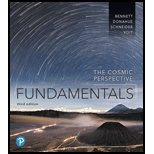
Pearson eText The Cosmic Perspective Fundamentals -- Instant Access (Pearson+)
3rd Edition
ISBN: 9780135775394
Author: Jeffrey Bennett, Megan Donahue
Publisher: PEARSON+
expand_more
expand_more
format_list_bulleted
Textbook Question
Chapter 6, Problem 15SEQ
Explain all answers clearly, with complete sentences and proper essay structure if needed. An asterisk (*) designates a quantitative problem, for which you should show all your work.
The Role of Jupiter. Suppose that Jupiter had never existed. Describe at least three ways in which our solar system would be different, and clearly explain why.
Expert Solution & Answer
Want to see the full answer?
Check out a sample textbook solution
Students have asked these similar questions
Please solve and answer the problem correctly please. Thank you!!
Please solve the question answer the problem correctly please. Thank you!!
Please solve and answer the problem correctly please. Thank you!!
Chapter 6 Solutions
Pearson eText The Cosmic Perspective Fundamentals -- Instant Access (Pearson+)
Ch. 6 - Choose the best answer to each of the following....Ch. 6 - Choose the best answer to each of the following....Ch. 6 - Choose the best answer to each of the following....Ch. 6 - Choose the best answer to each of the following....Ch. 6 - Choose the best answer to each of the following....Ch. 6 - Choose the best answer to each of the following....Ch. 6 - Choose the best answer to each of the following....Ch. 6 - Choose the best answer to each of the following....Ch. 6 - Choose the best answer to each of the following....Ch. 6 - Choose the best answer to each of the following....
Ch. 6 - Choose the best answer to each of the following....Ch. 6 - Prob. 12QQCh. 6 - Explain all answers clearly, with complete...Ch. 6 - Explain all answers clearly, with complete...Ch. 6 - Explain all answers clearly, with complete...Ch. 6 - Explain all answers clearly, with complete...Ch. 6 - Explain all answers clearly, with complete...Ch. 6 - Explain all answers clearly, with complete...Ch. 6 - Explain all answers clearly, with complete...Ch. 6 - Explain all answers clearly, with complete...Ch. 6 - Explain all answers clearly, with complete...
Additional Science Textbook Solutions
Find more solutions based on key concepts
All of the following processes are involved in the carbon cycle except: a. photosynthesis b. cell respiration c...
Human Biology: Concepts and Current Issues (8th Edition)
A source of electromagnetic radiation produces infrared light. Which of the following could be the wavelength ...
Chemistry: The Central Science (14th Edition)
In cats, tortoiseshell coat color appears in females. A tortoiseshell coat has patches of dark brown fur and pa...
Genetic Analysis: An Integrated Approach (3rd Edition)
23. How many significant figures are there in the following values?
a. 0.05 × 10-4 b. 0.00340
c. 7.2 × 104 ...
Physics for Scientists and Engineers: A Strategic Approach, Vol. 1 (Chs 1-21) (4th Edition)
The pHactivity profile for glucose-6-phosphate isomerase indicates the participation of a group with a pKa = 6....
Organic Chemistry (8th Edition)
Using the forked-line, or branch diagram, method, determine the genotypic and phenotypic ratios of these trihyb...
Concepts of Genetics (12th Edition)
Knowledge Booster
Learn more about
Need a deep-dive on the concept behind this application? Look no further. Learn more about this topic, physics and related others by exploring similar questions and additional content below.Similar questions
- Please solve this problem correctly please and be sure to provide explanation on each step so I can understand what's been done thank you. (preferrably type out everything)arrow_forwardUse a calculation to determine how far the fishing boat is from the water level .Determine distance Yarrow_forwardNo chatgpt pls will upvote Already got wrong chatgpt answerarrow_forward
- 2. 1. Tube Rating Charts Name: Directions: For the given information state if the technique is safe or unsafe and why. 60 Hertz Stator Operation Effective Focal Spot Size- 0.6 mm Peak Kilovolts MA 2 150 140 130 120 110 100 90 80 70 2501 60 50 40 30 .01 .02 .04.06 .1 .2 .4.6 1 8 10 Maximum Exposure Time In Seconds Is an exposure of 80 kVp, 0.1 second and 200 mA within the limits of the single phase, 0.6 mm focal spot tube rating chart above? Is an exposure of 100 kVp, 0.9 second and 150 mA within the limits of the single phase, 0.6 mm focal spot tube rating chart above?arrow_forwardQ: You have a CO2 laser resonator (λ = 10.6 μm). It has two curved mirrors with R₁=10m, R2= 8m, and mirror separation /= 5m. Find: R2-10 m tl Z-O 12 R1-8 m 1. Confocal parameter. b= 21w2/2 =√1 (R1-1)(R2-1)(R1+R2-21)/R1+R2-21) 2. Beam waist at t₁ & t2- 3. Waist radius (wo). 4. 5. The radius of the laser beam outside the resonator and about 0.5m from R₂- Divergence angle. 6. Radius of curvature for phase front on the mirrors R₁ & R2-arrow_forwardNo chatgpt pls will upvotearrow_forward
arrow_back_ios
SEE MORE QUESTIONS
arrow_forward_ios
Recommended textbooks for you
 AstronomyPhysicsISBN:9781938168284Author:Andrew Fraknoi; David Morrison; Sidney C. WolffPublisher:OpenStax
AstronomyPhysicsISBN:9781938168284Author:Andrew Fraknoi; David Morrison; Sidney C. WolffPublisher:OpenStax
 Foundations of Astronomy (MindTap Course List)PhysicsISBN:9781337399920Author:Michael A. Seeds, Dana BackmanPublisher:Cengage Learning
Foundations of Astronomy (MindTap Course List)PhysicsISBN:9781337399920Author:Michael A. Seeds, Dana BackmanPublisher:Cengage Learning
 Stars and GalaxiesPhysicsISBN:9781305120785Author:Michael A. Seeds, Dana BackmanPublisher:Cengage Learning
Stars and GalaxiesPhysicsISBN:9781305120785Author:Michael A. Seeds, Dana BackmanPublisher:Cengage Learning Glencoe Physics: Principles and Problems, Student...PhysicsISBN:9780078807213Author:Paul W. ZitzewitzPublisher:Glencoe/McGraw-Hill
Glencoe Physics: Principles and Problems, Student...PhysicsISBN:9780078807213Author:Paul W. ZitzewitzPublisher:Glencoe/McGraw-Hill

Astronomy
Physics
ISBN:9781938168284
Author:Andrew Fraknoi; David Morrison; Sidney C. Wolff
Publisher:OpenStax


Foundations of Astronomy (MindTap Course List)
Physics
ISBN:9781337399920
Author:Michael A. Seeds, Dana Backman
Publisher:Cengage Learning


Stars and Galaxies
Physics
ISBN:9781305120785
Author:Michael A. Seeds, Dana Backman
Publisher:Cengage Learning

Glencoe Physics: Principles and Problems, Student...
Physics
ISBN:9780078807213
Author:Paul W. Zitzewitz
Publisher:Glencoe/McGraw-Hill
Kepler's Three Laws Explained; Author: PhysicsHigh;https://www.youtube.com/watch?v=kyR6EO_RMKE;License: Standard YouTube License, CC-BY